How Can We Avoid A Food Crisis That's Less Than A Decade Away
Background
In 1798, Thomas Malthus warned that since population grew exponentially and agricultural production grew only arithmetically, humanity could expect a gloomy future of limits and misery due to hunger. Thankfully we now know that his forecast didn’t work out. In fact, the brightest years of Western Civilization followed in the 200 years after his prediction, largely because he underestimated the power of human ingenuity to boost food production. Yield increases beyond the wildest fantasies of Malthus’s most bullish contemporaries have continued to this day. US farmers in Iowa harvest five times as much corn in 2017 as their grandfathers and grandmothers did on the same parcels of land in 1940.
Global production improvement, however, has not been uniform. Major producing regions have emerged as others became major importers. Jumps in demand have not caused disaster, because every time world famine threatened, innovation appeared and saved the day. But per capita incomes and population in emerging economies are rising at unprecedented speeds and in a more nuanced and potentially dangerous fashion than one or two simple numbers indicate. Given current USDA and FAO production projections, which assume the continuation of current farm practices, the world will run out of food. We will need another wave of innovation to get through the coming calorie crisis.
Calories count
When we set out to solve at which point global demand for food would surpass our current agricultural system’s structural capacity to meet that demand, we first analyzed a basket of key agricultural commodities, such as various cereals, oil crops, and roots and tubers. These crops are critical components of diets around the globe. The straightforward calculation would have been to find the difference between the production and consumption quantity of the commodities in various countries. But rather than looking at the mass produced and consumed, we calculated the caloric value of each tonne of food before we examined country-specific trends. We care about food for its nutrition, not how much it weighs. By approaching the model from a caloric viewpoint, Gro aimed to bring the food security discussion closer to what matters and found results that suggested we need a more imminent call to action.
It’s easy to quantify production or consumption in tonnes and use the same measurement when discussing food shortages, but that doesn’t take nutritional needs into consideration. For example, a kilogram of corn has over 2.5 times the number of calories as a kilogram of rice and over twice the number of calories as a kilogram of cassava. Affluent diets further stress the supply balance. A kilogram of beef requires about 6.5 kilograms of grain to produce.
Using data that had been transformed through our ontology, we aggregated consumption and production statistics for our basket of core crops in every country around the world from 1960 to the present. First, the amount of calories in a tonne of each crop was calculated to arrive at an annual sum of calories consumed and produced in each country. Next, the calorie gap was defined in each country to be the difference between the calories domestically produced and consumed.
The world 40 years ago
Just 40 years ago, less than a handful of regions had a calorie surplus. People outside of Europe and the Americas had little protein in their diets, and most of Europe was net flat to small net importers of calories. China, during this period, maintained a small net export balance. The agricultural system supported only 3.5 billion people.
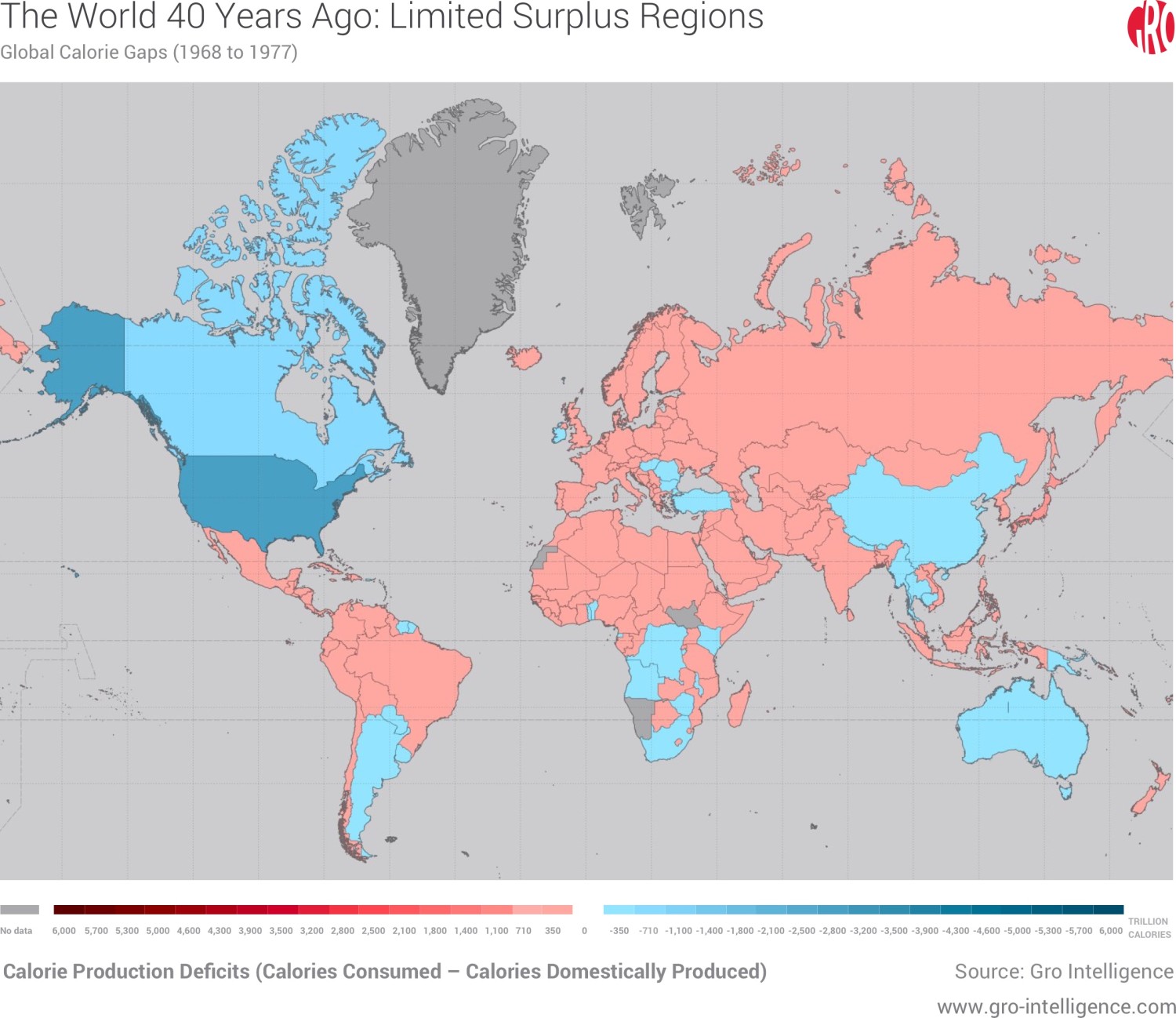
The situation today
40 years later, the world’s population has more than doubled. Diets worldwide have improved greatly, with protein in some form now a staple in most of the world. China has become the largest food importer in history by simultaneously growing its population and upgrading its protein consumption with new prosperity. South American production agriculture has boomed to join North America as the breadbasket of the world. Europe and Russia have fully recovered from the devastation of World War Two to become net exporters of calories. The Green Revolution in India allowed the country to become food self-sufficient and in the past decade even a small net exporter.

What the future holds
According to Gro Intelligence forecasts, the increases of net calorie imports to China, India, and Africa will far exceed the increases in production from North America, South America, and Europe, and there will be a nearly 214 trillion calorie gap per year in 2027. All this assumes that there will be no systemic change to meet the calorie deficit challenge.
Two examples illustrate the daunting dimensions of the problem as currently defined. A tonne of corn (maize) has about 3.65 million calories, so we would need an extra 58.4 million tonnes each year by 2027 if we wanted to fill the gap with only corn. The largest producer in the world (the US) will only produce around 360 million tonnes in 2017, and 139 million of those will go to make ethanol.
Another way to think about these hundreds of trillions of calories is to link it to Big Macs. A Big Mac has 563 calories. This means that in 2027, our global food system will be short of 379 billion Big Macs to feed everyone in India, Africa, and China. This, by the way, is a lot more Big Macs than McDonald's has ever sold.
Growing populations
Calorie consumption in a country grows in two principal and intertwined ways: by income growth and by population growth. The world already saw the multiplier effect from high levels of both in China over the past 20 years. China and India are two of the strongest economies in the world and the two will continue to grow. Africa’s story over the near future is a similar tale of growth. Africa’s population is projected to overtake that of China and India in just six years. In a repeat of the China experience, high per capita income growth is projected to occur across the African continent as well. Several African countries have already been growing at record rates in the past decade. By 2023, China, India, and Africa combined will make up over half the world’s population.

While population growth has a readily understood effect on caloric needs, economic growth takes more study to completely assess its impact.
To figure out the exact effects that this growth will have on calorie demand in the future, we first calculated the relationship between non-extractive GDP per capita and calorie consumption. Non-extractive GDP excludes the mining and energy industries because profits in these sectors usually don’t get widely distributed or contribute to caloric consumption growth. As an example, many oil-rich countries have the same per capita caloric requirements as their poorer neighbors because the oil wealth stays in the ruling class’s hands.
We then forecasted future non-extractive GDP per capita using GDP and population forecasts. Caloric consumption per capita forecasts were then created by applying the relationship between non-extractive GDP per capita and consumption of calories to future non-extractive GDP per capita. The total caloric forecast for each country in the world was then obtained by multiplying those forecasts by population forecasts.
After obtaining projected caloric needs, the next step was determining future production. Growth forecasts for each crop’s production in each country were used along with the calories/tonne constants calculated earlier.
With those computations finished, we were able to determine whether future production would be able to meet the demand forecasts generated by Gro Intelligence. Our findings showed that even accounting for future production increases, the growth in demand would be so large that the world would have a 214 trillion calorie gap per year in 2027.
How we get to a 214 trillion a year deficit
Increased caloric intake due to income growth compounded by exploding populations creates a grave economic quandary, especially for those in emerging economies. Even more troubling, there are no longer individual countries that the world can rely on to meet growing food demand. Rather, it will take innovation across entire regions to create the required caloric values. Luckily, history provides several lessons from which to learn. While Europe, North America and South America have historically provided the world with the predominant share of calories, the time has come for India and African countries to lead the charge.
India and most countries on the African continent were in similar food and agricultural situations by the start of the 1960s. But while India went on to undergo a Green Revolution that transformed the country into a self-sufficient agricultural producer, Africa did not. And in the last decade, India has become a small net exporter of calories. Riding high on its Green Revolution success, however, India’s agricultural sector has not pushed forward to further modernization. Without an emergency similar to that of the early 1960s, the speed of Indian reform has slowed to a crawl.

Indian agriculture is dependent on the monsoon, and therefore the country’s production is volatile. In 2016, India net imported the largest amount of wheat that it had in 10 years due to low production. Although current rice yields are only at about 40% of their estimated potential (after accounting for water and soil limitations), India faces economic and structural challenges as it attempts to improve its agricultural efficiency.
Tragically, Africa currently fills a 300 trillion calorie gap through costly imports. As the continent’s economy and population continue to grow, so too will its requirement for calories. Incorporating optimistic production growth assumptions which expect a considerable increase in African agricultural land areas (despite the fact that this would require deforestation) and taking into account Gro’s demand forecasts, gaps will increase for every region.
In particular, northern Africa’s already large food imports will continue to increase. Southern Africa currently faces a larger absolute calorie gap than eastern Africa, but both regions will see their need for imports rise at a similar pace. The rate at which western Africa’s calorie production gap increases will start to slow, in line with current government policies in the region. Central Africa hovers around zero net food imports, as it has done historically.
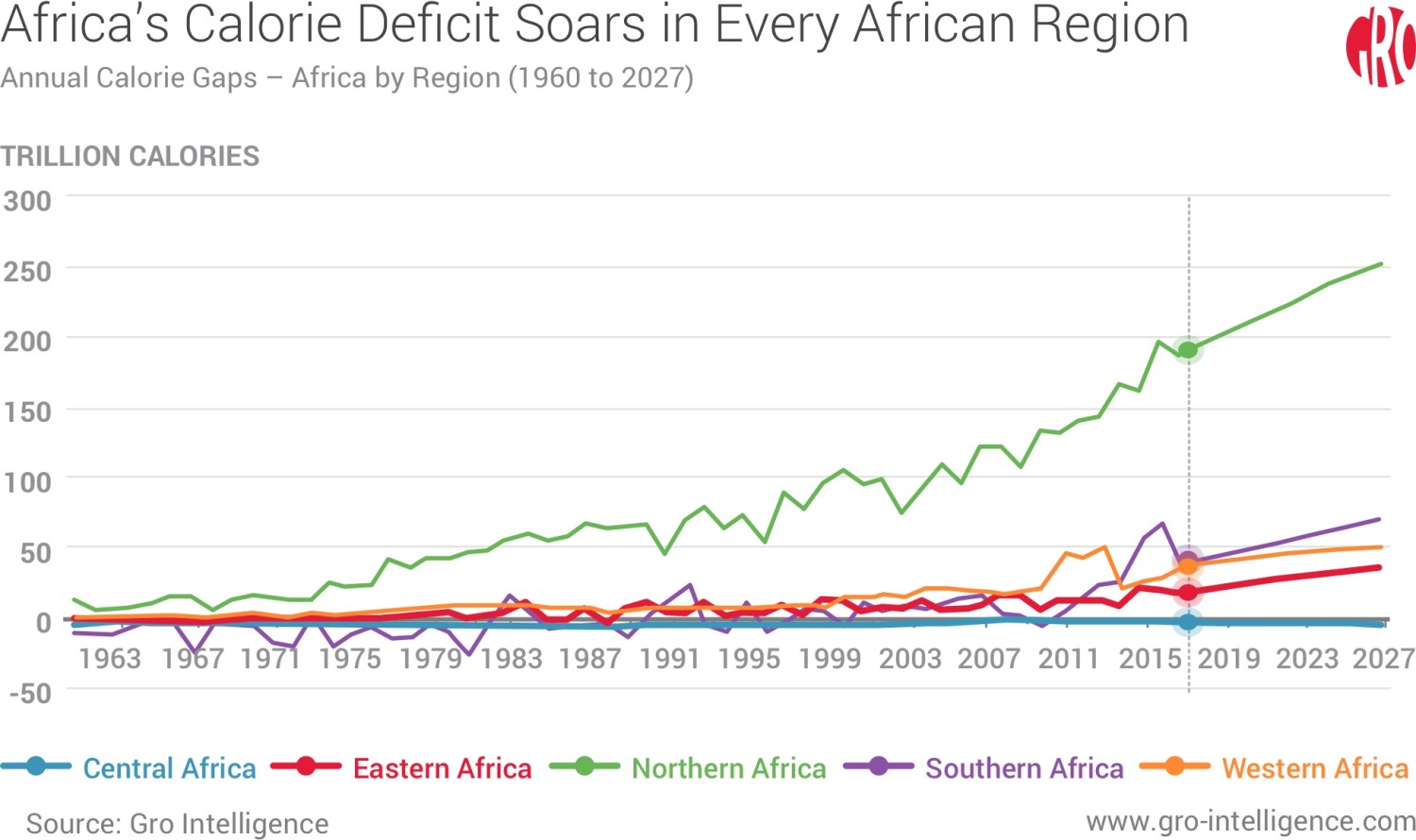
The continent’s huge untapped resources, with yields consistently under 50% of potential and vast tracts of fallow land, cannot come to the rescue under the current system and set of practices, which prevent many of the innovations that could lead to self-sufficiency. On the other hand, systemic and structural change to how agriculture functions across the African continent could quickly address some of the worst problems. The gulf between yields in the US and all of Sub-Saharan Africa shows how much room exists for improvement and can act as a source of inspiration.
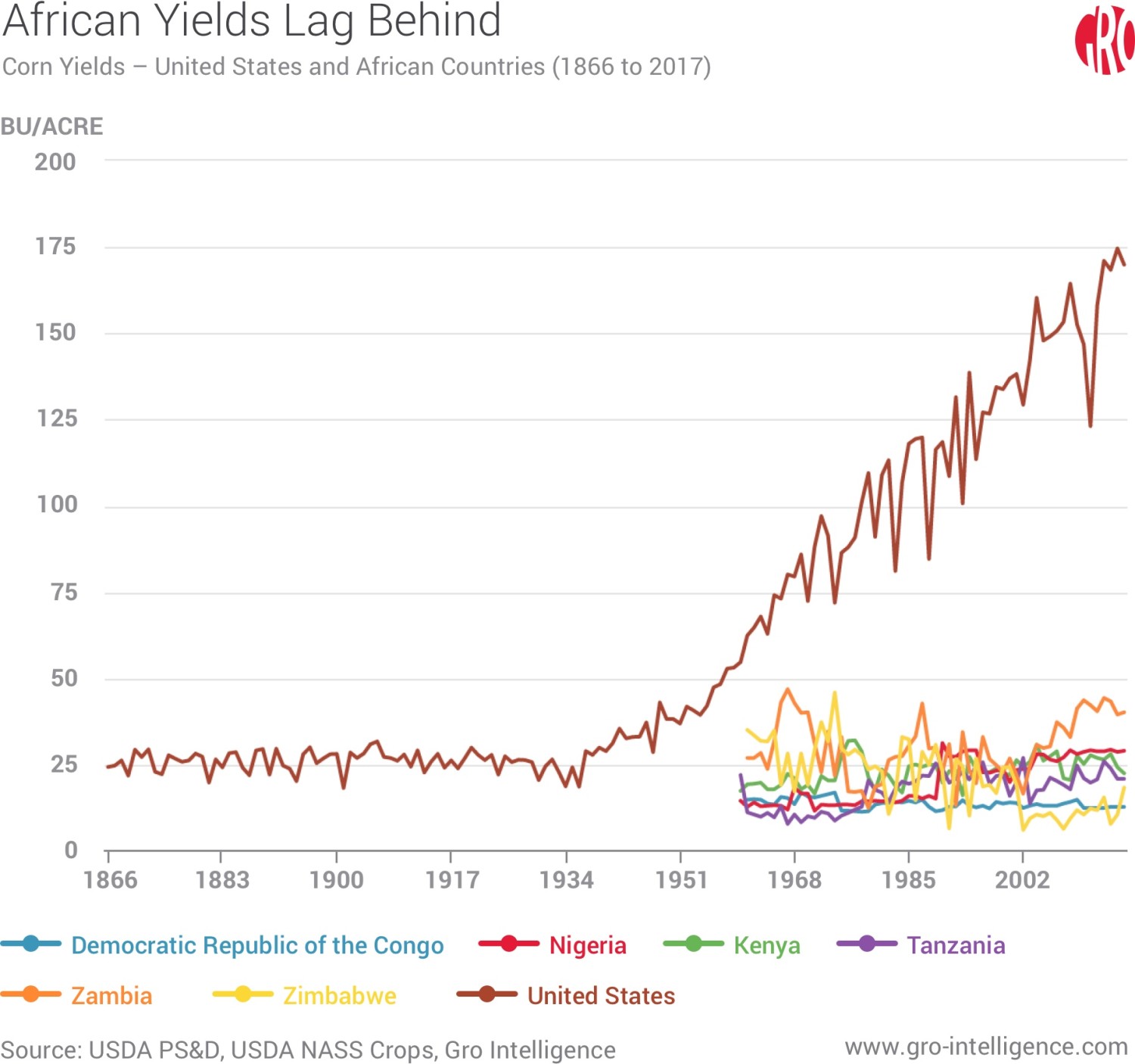
Once we add China into the balance, we can see the true scope of the global calorie gap. China is currently at approximately 70% of its maximum potential yield for rainfed corn. Most analysts agree that its production will not be able to increase by much due to acreage and water limits. Since China has farmed its land intensively for thousands of years, they have a real shortage of additional land to plant, and what the country already cultivates suffers from varying degrees of soil depletion. Crops go thirsty because China’s dazzling success in heavy industry has contaminated much of the remaining ground- and river water. Yet, as the country grows richer, its government continues to implement policies, such as its recent ethanol mandate, that will sharply boost Chinese demand for agricultural commodities such as corn.
The growth of the three regions will create a massive global calorie demand that far surpasses constrained production. With North America and Europe producing at close to peak efficiency and South America rising to meet global demand, production from these regions will not be enough to cover the gap.

North American agriculture has grown significantly since the 1960s, largely due to improvements in yield and technology. But these improvements over the last 50 years or so are now leveling off, and it’s not clear that North America has the ability to improve its agricultural yields much further. More importantly, we’re at a point where the acreage under use by agriculture no longer has the opportunity to expand on the continent. Going forward, we and most others expect food production in the US and Canada to grow only slowly.
The European story is a similar one of near-constant production. Ancient farmland will not expand, and yields will grow slowly, if at all. Observers rightly call the past few decades of sharp yield increases in developed countries miracles. Expecting them to occur in the next decades as well in the same regions seems foolish, especially when so much potential remains unused in India and Africa.
And so, without substantial change in emerging economies or a continued miracle in North America and Europe, we reluctantly end up depending on growth in South America’s farm sector. Brazil’s new agricultural production will only come from cleared and planted acreage in newly deforested areas of the Amazon. The possible climate consequences should strike fear into the hearts of policy makers and civil society due to a loss of carbon-sequestering foliage. Amazon deforestation, with all its negative ramifications, seems likely if the world fails to address growing caloric deficits at their sources.

Conclusion
The world has experienced similar crises in the past. We narrowly escaped a deficit scenario like this one not too long ago when China’s emerging middle class started to prosper and consume more protein. South American farmers, recognizing an incredible opportunity, began planting more soybeans. When those beans crossed the Pacific Ocean, they satisfied China’s new demand without resultant deprivation anywhere else.
The currently popular proposed solutions to global food security tend to rely wholly or in part on behavioral changes across large swaths of the developed world. They have a point. Reducing food waste, eliminating beef from diets, or ending biofuel production would greatly add to the calories available. But it seems unlikely that consumers will voluntarily and permanently sustain these changes for abstract ideas of others’ welfare.
Focusing efforts on improving net import regions’ agricultural practices so that more calories come from local sources makes more sense. A new form of commercialization can become the path forward to self-sufficiency for people who still toil in traditional, low-yielding agriculture. Leapfrogging the Green Revolution reforms of the 1960s, the new commercialization will take full advantage of advanced analytic techniques and provision of quality data to help farmers, bankers, insurers, government officials, food and beverage companies, and players across the whole agriculture ecosystem to make decisions informed at a whole new level. The new commercialization can clear the logjam of untrustworthy risk appraisal that keeps poor farmers from accessing capital desperately needed for investment in yield improvement. The new commercialization, however, also embraces the co-existence of commercial farms alongside small scale farmers. Large, commercial farms are undeniably able to provide certain economies of scale that smallholder farms can leverage. In such a world, the burden of growth does not rest on small scale farmers alone.
With the power of modern networked data infrastructure, the vast resources of deficit regions across Sub-Saharan Africa and in India can be brought to bear on the problem of food security. The information revolution can provide the means for policy, production, and finance to work together in innovative ways to forge a novel structure that optimizes the contributions of small and large enterprises to secure the calories that people will need.
Change that has streamlined industry in the net exporting regions of the world will come to the entire ecosystem of agriculture and all the players involved. As the agricultural system evolves toward realization of its potential, that’s how innovation will again save humankind from the Malthusian trap as it has many times before.
 Insight
InsightIndia Looks Set for a Big Chickpea Crop
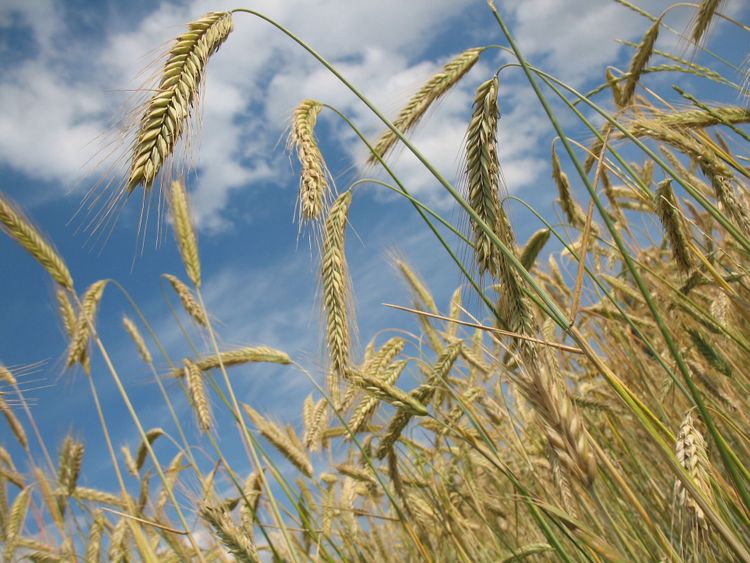 Insight
InsightIndia Plans Further Actions to Stem Soaring Domestic Wheat Prices
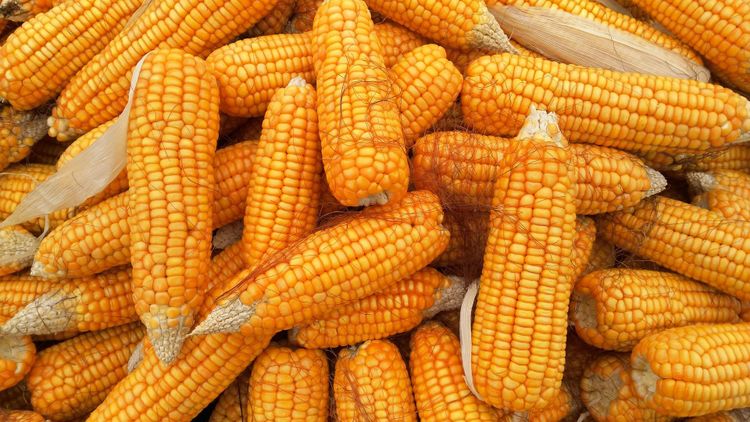 Insight
InsightBrazil Seen Ramping Up Corn Production as Global Trade Flows Shift
 Insight
Insight

 Search
Search